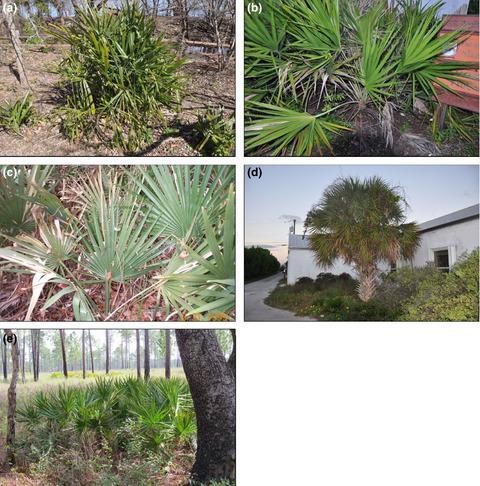当前位置:
X-MOL 学术
›
Ecol. Evol.
›
论文详情
Our official English website, www.x-mol.net, welcomes your
feedback! (Note: you will need to create a separate account there.)
Climate change winners and losers: The effects of climate change on five palm species in the Southeastern United States
Ecology and Evolution ( IF 2.3 ) Pub Date : 2020-09-01 , DOI: 10.1002/ece3.6697 Christopher J Butler 1 , Matt Larson 1
Ecology and Evolution ( IF 2.3 ) Pub Date : 2020-09-01 , DOI: 10.1002/ece3.6697 Christopher J Butler 1 , Matt Larson 1
Affiliation

|
Palms (Arecaceae) are a relatively speciose family and provide materials for food, construction, and handicraft, especially in the tropics. They are frequently used as paleo‐indicators for megathermal climates, and therefore, it is logical to predict that palms will benefit from predicted warmer temperatures under anthropogenic climate change. We created species distribution models to explore the projected ranges of five widespread southeastern North American palm species (Rhapidophyllum hystrix, Sabal etonia, Sabal minor, Sabal palmetto, and Serenoa repens) under four climate change scenarios through 2070. We project that the amount of habitat with >50% suitability for S. etonia will decline by a median of 50% by 2070, while the amount of habitat with >50% suitability S. minor will decline by a median of 97%. In contrast, the amount of suitable habitat for Rhapidophyllum hystrix will remain stable, while the amount of suitable habitat for Serenoa repens will slightly increase. The projected distribution for S. palmetto will increase substantially, by a median of approximately 21% across all scenarios. The centroid of the range of each species will shift generally north at a median rate of 23.5 km/decade. These five palm species have limited dispersal ability and require a relatively long time to mature and set fruit. Consequently, it is likely that the change in the distribution of these palms will lag behind the projected changes in climate. However, Arecaceae can modify physiological responses to heat and drought, which may permit these palms to persist as local conditions become increasingly inappropriate. Nonetheless, this plasticity is unlikely to indefinitely prevent local extinctions.
中文翻译:

气候变化的赢家和输家:气候变化对美国东南部五种棕榈树的影响
棕榈树(槟榔科)是一个相对种类丰富的科,为食物、建筑和手工艺品提供材料,特别是在热带地区。它们经常被用作超高温气候的古指标,因此,预测棕榈树将受益于人为气候变化下预测的气温升高是合乎逻辑的。我们创建了物种分布模型,以探索到 2070 年四种气候变化情景下北美东南部分布广泛的五种棕榈树( Rhapidophyllum hystrix 、 Sabal etonia 、 Sabalminor 、 Sabal palmetto和Serenoa repens )的预测范围。我们预测栖息地的数量到 2070 年,对S. etonia的适宜度 >50% 的栖息地将平均减少 50%,而对S. micro的适宜度 >50% 的栖息地数量将平均减少 97%。相比之下,剑叶藻的适宜栖息地数量将保持稳定,而锯棕榈的适宜栖息地数量将略有增加。棕榈树的预计分布将大幅增加,在所有情景中中位数约为 21%。每个物种分布范围的质心将以平均每十年 23.5 公里的速度向北移动。这五种棕榈树的传播能力有限,需要相对较长的时间才能成熟和结果。因此,这些棕榈树分布的变化很可能会落后于预计的气候变化。然而,槟榔科植物可以改变对炎热和干旱的生理反应,这可能会让这些棕榈树在当地条件变得越来越不合适的情况下继续存在。 尽管如此,这种可塑性不太可能无限期地阻止局部灭绝。
更新日期:2020-10-12
中文翻译:

气候变化的赢家和输家:气候变化对美国东南部五种棕榈树的影响
棕榈树(槟榔科)是一个相对种类丰富的科,为食物、建筑和手工艺品提供材料,特别是在热带地区。它们经常被用作超高温气候的古指标,因此,预测棕榈树将受益于人为气候变化下预测的气温升高是合乎逻辑的。我们创建了物种分布模型,以探索到 2070 年四种气候变化情景下北美东南部分布广泛的五种棕榈树( Rhapidophyllum hystrix 、 Sabal etonia 、 Sabalminor 、 Sabal palmetto和Serenoa repens )的预测范围。我们预测栖息地的数量到 2070 年,对S. etonia的适宜度 >50% 的栖息地将平均减少 50%,而对S. micro的适宜度 >50% 的栖息地数量将平均减少 97%。相比之下,剑叶藻的适宜栖息地数量将保持稳定,而锯棕榈的适宜栖息地数量将略有增加。棕榈树的预计分布将大幅增加,在所有情景中中位数约为 21%。每个物种分布范围的质心将以平均每十年 23.5 公里的速度向北移动。这五种棕榈树的传播能力有限,需要相对较长的时间才能成熟和结果。因此,这些棕榈树分布的变化很可能会落后于预计的气候变化。然而,槟榔科植物可以改变对炎热和干旱的生理反应,这可能会让这些棕榈树在当地条件变得越来越不合适的情况下继续存在。 尽管如此,这种可塑性不太可能无限期地阻止局部灭绝。









































 京公网安备 11010802027423号
京公网安备 11010802027423号